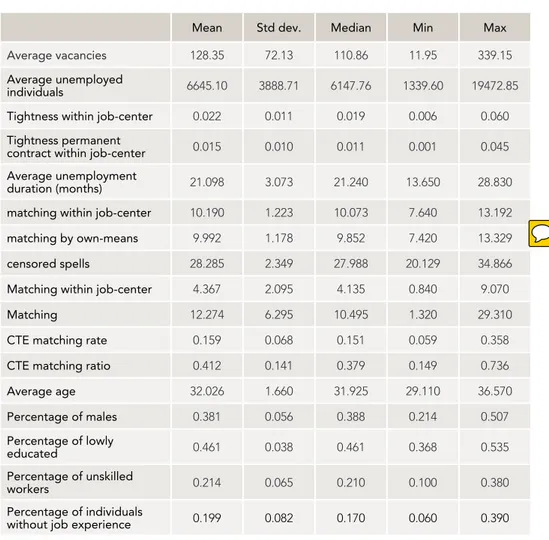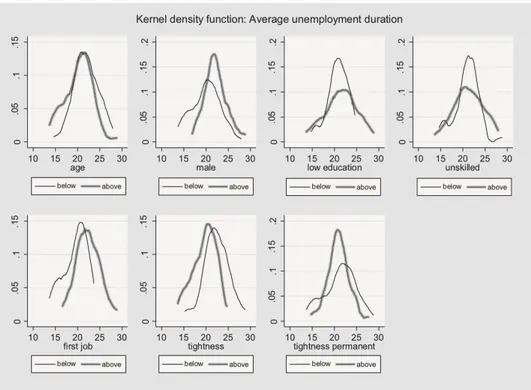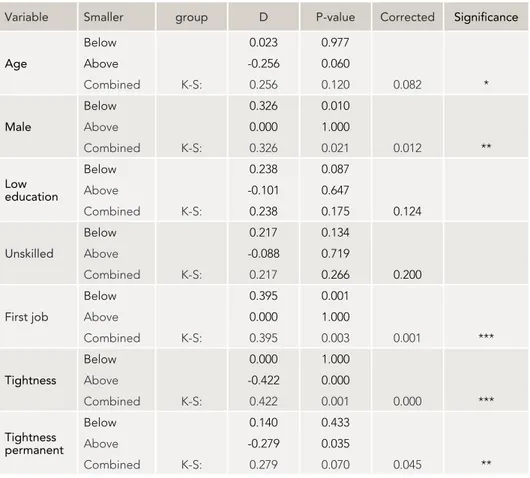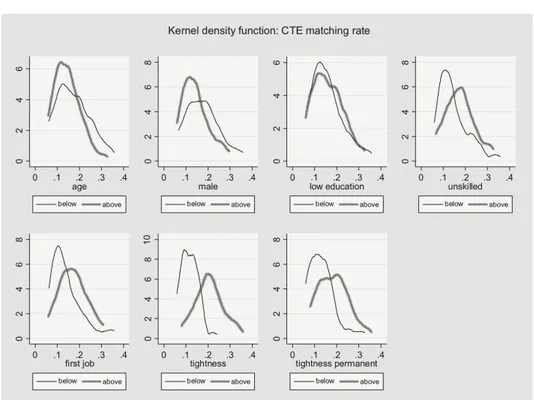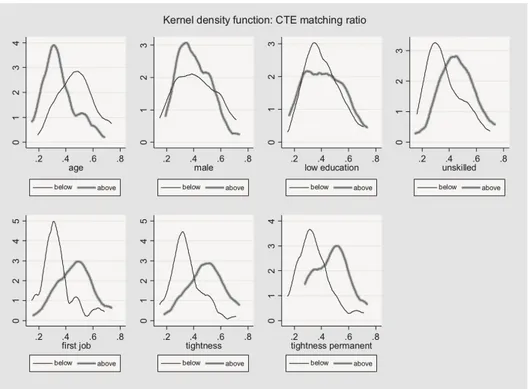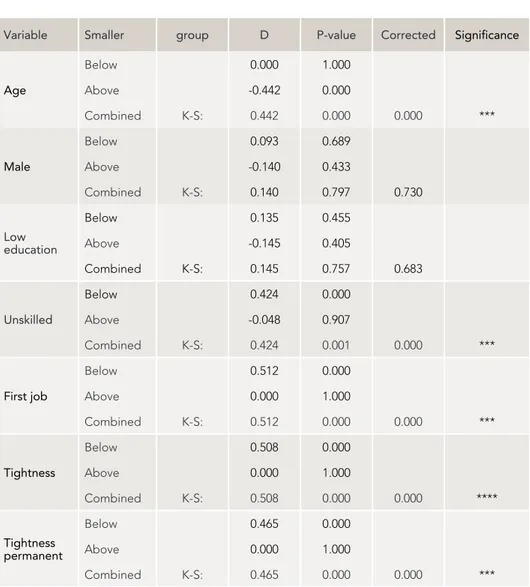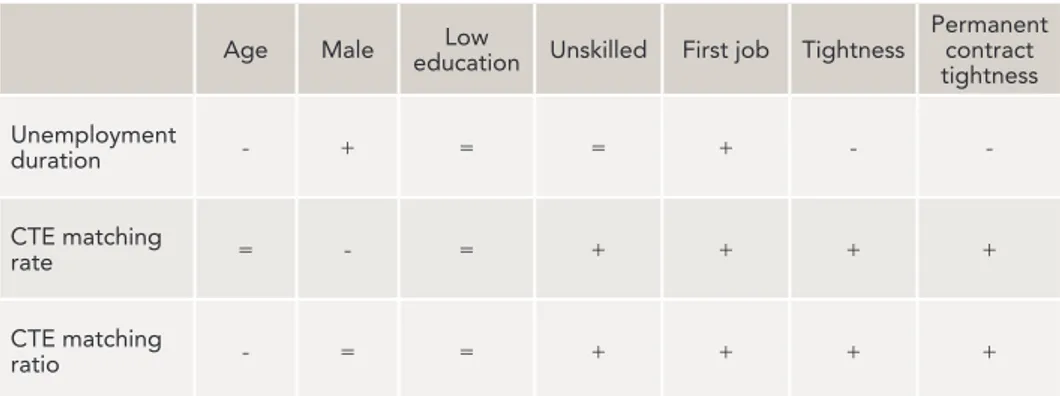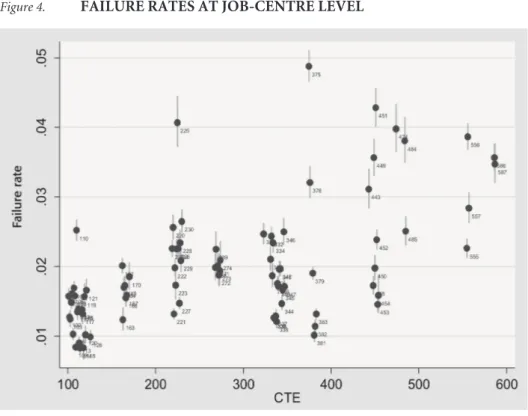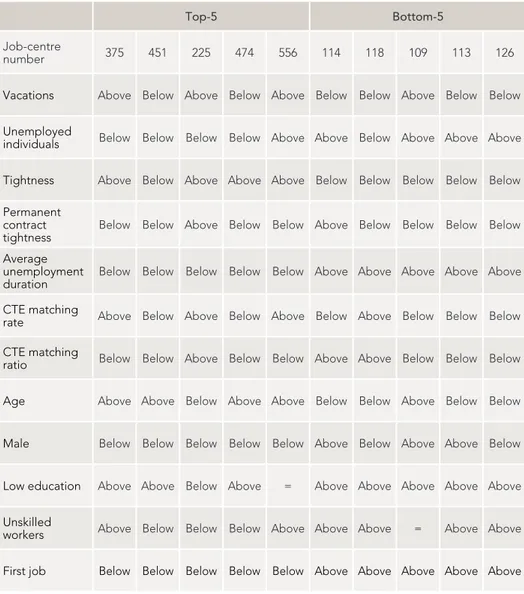job-centers
En este artículo se analiza el desempeño del sistema nacional de 86 oficinas de empleo público de Portugal que se ocupan de poner en contacto a las personas en paro con las ofer-tas de trabajo. Para ello se utiliza un conjunto de microdatos correspondiente al periodo 1998-2002 que permite la construcción de fases de desempleo individual y su duración; así como los resultados laborales subsiguientes, teniendo en cuenta al mismo tiempo caracte-rísticas individuales tales como la edad, los estudios, el género, las experiencias laborales en el pasado y otras variables del mercado laboral definidas a nivel local de mercado de trabajo o a nivel de oficina de empleo. Entre las diversas conclusiones y recomendaciones para las políticas públicas debe tenerse en cuenta que las oficinas de empleo son un recurso muy im-portante para promover la equiparación laboral de los trabajadores jóvenes y no cualifica-dos y de los trabajadores sin experiencia laboral.
Artikulu honetan aztertzen da Portugalgo enplegurako 86 bulegoren estaldura nazionalaren sis-temaren jarduna. Bulego horien zerbitzu publikoa langabezian dauden pertsonak lan eskaintze-kin kontaktuan jartzea da. Horretarako, 1998-2002 aldiko datu sorta bat erabiltzen da. Ho-riekin, posiblea da langabezi-iraupen aldi-indibidualak eta ondorengo lan emaitzak eraikitzea, aldi berean, kontuan izanik bakoitzaren ezaugarriak (adina, ikasketak, generoa eta iraganeko lan esperientziak) eta lan merkatuko beste aldagai batzuk, tokiko lan merkatu mailan edo enple-gu bulego mailan definiturik. Ondorio eta gomendio politiko desberdinen artetik, kontuan izan behar da enplegu bulegoak baliabide oso garrantzitsua direla, langile gazte eta ez kualifikatuen, eta aurretiaz lan esperientziarik izan ez duten langileen lan egokitzapena sustatzeko.
This paper analyzes the performance of the country-wide system of 86 job-centers in Portugal, which have the public mandate of matching unemployed individuals with vacancies. The paper uses a rich micro dataset for the years 1998-2002 which allows the construction of individual unemployment duration spells and subsequent employment outcomes, while observing individual characteristics such as age, education, gender and past job experiences and other labour-market variables defined at the local-labour market or job-center level. Among the several conclusions and policy recommendations, it should be noted that job-centers are a most important resource in promoting the matching of young and unskilled workers and of workers with no previous job experiences.
109
University of Chieti-Pescara
António Gomes de Menezes
University of the AzoresTable of contents
1. Introduction
2. Public employment services 3. Data and methods
4. Results 5. Conclusions
Bibliographic References Appendix
Palabras clave: servicios públicos de empleo, resultados de los centros de empleo, duranción del desempleo,
tasa de colocación, análisis de supervivencia
Keywords: public employment services, job-centers performance, unemployment duration, matching rate,
survival analysis
JEL codes: J68, J64, C14
Entry Date: 31/01/2018 Acceptance Date: 05/03/2018
1. INTRODUCTION1
Labour market performance is one of the most important economic problems of modern societies, which depend on flexible and dynamic labour markets to match individuals with suitable jobs, leading thus to individual experiences which are productive and dignifying both at the personal and at society level. Hence, it is only but normal to recognize that labour market performance has occupied econo-mists and policymakers alike. In this paper we study the labour market performance of a highly salient feature of the Portuguese labour market, namely the performance of the Portuguese system of job-centers (Centro de Empregos, CTE), the
corner-1 The authors wish to thank Dr. Valentina Del Greco for her technical support in making Portuguese
110
stone of the Portuguese Public Employment Services (PES)2. As in many other
countries, Portugal has adopted a system of country-wide job-centers which are, in their essence, a building block of Portuguese active labour market policies. The job-centers are responsible for registering individuals who are actively looking for jobs and provide placement and counselling services. Quite importantly, the job-centers receive vacancies posted by firms and actively attempt to match unemployed indi-viduals with those vacancies. It should also be noted that for unemployed people to become eligible to collect unemployment benefits, they have to be registered at a job-center. Therefore, job-centers, which cover the entire Portuguese territory, pro-vide important services for all unemployed individuals, not only with respect their employment or re-employment prospects, but also with respect their income sup-port (in fact, unemployed individuals must meet certain criteria including attending meetings and interviews to preserve their eligibility status to collect unemployment benefits). In summary, the job-centers are an integral and critical part of the dynam-ics of the Portuguese labour-market and it is only but natural to study how effective they are in promoting higher (re)employment probabilities.
The Portuguese labour market is characterized by stringent employment protec-tion legislaprotec-tion. There is a significant co-existence between permanent-contracts and fixed-term-contracts, which leads to a dual-labour-market characterization of the Portuguese labour market. It should also be noted that unemployment duration is relatively high, even in periods of relatively low unemployment (Portugal and Blanchard 2001). Therefore, when analyzing the Portuguese labour market, it is of paramount importance to analyze unemployment duration and its dual-nature. In this paper, we investigate at the individual level and at the job-center level the deter-minants of job-center performance in matching individuals with vacancies both with permanent-contracts and with fixed-term contracts.
This paper evaluates the performance of Portuguese job-centers in promoting the employment and re-employment of registered individuals, by analyzing three distinct labour market outcomes: a) the average unemployment duration at job-centers level; b) the percentage of individuals leaving unemployment by matching vacancies at the job-center level over the whole of unemployed individuals; and c) the percentage of individuals leaving unemployment by matching vacancies at the job-center level over the whole of individuals finding a job. In addition, we deter-mine average failure rates and hazard functions at the job-center level (see Sciulli et
al. 2008 for a micro-econometric analysis of unemployment duration in Portugal).
This paper explores thus the geographic and individual wealth of data across job-centers and individuals of a micro dataset provided by the Instituto do Emprego e Formação Profissional (IEFP), the Portuguese Government owned and adminis-trated Institution responsible for the functioning of the job-centers, among other 2 See Agovino et al. (2013) for an efficiency analysis of Portuguese PES.
111 functions, such as training policies. The data span the period from 1998 to 2002 and
86 job-centers, providing, hence, interesting spatial and time variation. Individual data allow us to construct individual unemployment spells and outcomes, while controlling for several individual characteristics and other regional variables related to the local labour markets of the job-centers. The paper employs graphical and quantitative tools to study the performance of the job-centers, such as kernel-densi-ty functions, hazard rates and standard classical statistical tests.
We find robust evidence that job-centers provide a most valuable resource espe-cially for young and unskilled workers, and thus are a most important tool in pro-moting the labour market position of these disadvantaged groups.
The paper is organized as follows. Section 2 elaborates on PES and its impor-tance to an efficient labour market. Section 3 describes the data and methods em-ployed in the paper. Section 4 presents the results. Section 5 contains the most im-portant conclusions, including with respect policy-making.
2. PUBLIC EMPLOYMENT SERVICES
Labour market performance determines living standards and its improvement has been one of the main policy goals among developed countries. The OECD’s Jobs Strategy recommendations included five main areas: a) the reform of employment protection legislation; b) working hours negotiation between employers and employ-ees; c) the reduction of the cost of unskilled and part-time labour; d) the reduction of inactivity traps; and e) the improvement of the efficiency of the public employment service (OECD, 1998; Brandt et al., 2005). With respect the well-functioning of the PES the OECD prescribes the integration of three basic PES functions - placement and counselling services, the payment of unemployment benefits and management of la-bour market programmes -, regular contacts between claimants and PES and compe-tition via active private placement agencies (Jamet, 2006).
An efficient PES is essential to assure a rapid matching between workers and jobs; conversely, inefficiency is likely to be associated with longer vacancy and un-employment duration, which may, in turn, lead to discouragement and the loss of skills. The Portuguese labour market is characterised by «eurosclerosis», with low flow-rates between employment and unemployment and vice versa, resulting in an extremely high mean duration of unemployment (Portugal, 2008). Stringent em-ployment protection legislation and the unemem-ployment benefit system contribute to this poor labour market performance. Quite importantly, the functioning of the Portuguese PES represents a key-determinant in improving labour market perfor-mance, and its efficiency may depend on job-center characteristics, including local mismatches between individuals’ characteristics and vacant jobs’ characteristics.
112
Many studies assess the efficiency of matching markets and mechanisms and the role of mismatches between individuals’ and vacant jobs’ characteristics. Petrongolo and Pissarides (2001) focus on matching functions, mismatch and both macro and micro approaches to matching. Among micro-studies, Van Ours (1991) evaluates the effectiveness of the public employment office in the Netherlands using information about vacancy duration. Lindeboom, Van Ours and Renes (1994) use Dutch micro-data to study the effectiveness of job search comparing different recruitment channels, including PES. Sheldon (2003) uses data envelopment analysis to conclude that in 1997-1998 the Swiss PES reached roughly two thirds of its efficiency potential.
Portugal has been experiencing low job-flow rates which are associated with mis-matches in a sclerotic labour market (Blanchard and Portugal, 2001). Even during the late 90s and early 00s when Portugal experienced relatively low unemployment, un-employment duration was relatively high, with low job turnover and workers staying at jobs with low productivity. Hence, analysing the matching process in Portugal is paramount to making the Portuguese labour market more efficient and productive. 3. DATA AND METHODS
The analysis is based on IEFP data for the period from 1998 to 2002, which pro-vides information on registration and placement dates of individuals enrolled in 86 continental Portuguese job-centers (see IEFP 2000 for details).
We use IEFP data in two distinct manners. First, we aggregate microdata at centre level by using average values of variables’ distributions to characterize job-centers and assess their performance in promoting job matching. Second, we exploit the original microdata dimension of the IEFP dataset to apply survival analysis and return failure rates and hazard functions at job-center level3.
We consider three indicators to evaluate the performance of Portuguese job-centers. The first one is the average unemployment duration calculated at job-center level, corresponding to the average value of unemployment spell duration of the in-dividuals registered at a specific job-center in the period under investigation.
The second indicator consists in the job-center matching rate, which measures the percentage of individuals leaving unemployment by successfully matching va-cancies offered at the job-center level.
The third indicator consists in the job-center matching ratio, measuring the ra-tio between individuals leaving unemployment by successfully matching vacancies offered at the job-center level and the whole of individuals leaving unemployment (including those who find a job by their own means). The construction of the latter indicator is possible because IEFP data distinguishes individuals who find a job
113 cause they find a suitable job vacancy registered at the same job-center where the
in-dividual is registered, from those who find a job by their own means.
Whereas the second indicator returns an absolute measure of job-center capability in promoting matches between unemployed individuals and vacancies, the third indi-cator provides a relative measure of the same capability, properly discounted for the number of individuals who leave unemployment by their own means.
It is important to note that the average unemployment duration is based on all un-employment spell events at job-centers level, including censored spells, i.e. those obser-vations for which the exit from the unemployment pool is unobservable4. This means
that average unemployment duration returns an overall assessment of job-center effec-tiveness in placing registered individuals, and incorporates factors not strictly connect-ed to job-centers’ functioning, including local labour market conditions.
Distinguishing censored from uncensored spells and, in addition, individuals finding a job within the job-center from those individuals of find jobs by their own means reveals, as a matter of fact, a certain heterogeneity in terms of average unem-ployment duration. By construction, censored spells are longer than uncensored spells (28.28 months against 10.06 months). On the contrary, quite negligible differ-ences exist between average unemployment duration of individuals finding a job by their own means or matching with vacancies offered at the job-centers (9.99 months against 10.19 months). A certain degree of variability exists among job-centers in terms of average unemployment duration of censored and uncensored spells. This may be explained in terms of both distribution of registration dates (especially for censored spells) and local labour market conditions.
The other indicators, in turn, account for the capability of job-centers in plac-ing individuals in jobs, by linkplac-ing the number of matches at job-center level with the whole of individuals registered at the job-centers and the whole of individuals find-ing a job, respectively.
Figure A1 offers a visual inspection of the three performance indicators in the continental Portugal. Particularly, each map reports the performance of each job-centers according to the quartile distribution of average unemployment duration, CTE matching rate and CTE matching ratio. This preliminary descriptive analysis clarifies that the job-centers in the North and Lisbon regions experience the worst performance, while job-centers in the Algarve region, and partly, in the Center re-gion, perform better.
We attribute to each job-center individual and local labour market characteristics aggregated by using average values calculated over the 1998-2002 period. The characterization includes information related to age, gender, educational level, skill
4 Survival analysis assumes that the unemployment spell ends on December 2002, the final month
114
level, job experience and (pseudo) local labour market tightness5. This allows us to
distinguish job-centers according to relevant characteristics and, concomitantly, to learn about associations between those variables and outcome indicators.
Table 1 reports descriptive statistics of variables aggregated at job-center level by referring the average values.
Table 1. DESCRIPTIVE STATISTICS
Mean Std dev. Median Min Max
Average vacancies 128.35 72.13 110.86 11.95 339.15
Average unemployed
individuals 6645.10 3888.71 6147.76 1339.60 19472.85
Tightness within job-center 0.022 0.011 0.019 0.006 0.060
Tightness permanent
contract within job-center 0.015 0.010 0.011 0.001 0.045 Average unemployment
duration (months) 21.098 3.073 21.240 13.650 28.830
matching within job-center 10.190 1.223 10.073 7.640 13.192
matching by own-means 9.992 1.178 9.852 7.420 13.329
censored spells 28.285 2.349 27.988 20.129 34.866
Matching within job-center 4.367 2.095 4.135 0.840 9.070
Matching 12.274 6.295 10.495 1.320 29.310
CTE matching rate 0.159 0.068 0.151 0.059 0.358
CTE matching ratio 0.412 0.141 0.379 0.149 0.736
Average age 32.026 1.660 31.925 29.110 36.570 Percentage of males 0.381 0.056 0.388 0.214 0.507 Percentage of lowly educated 0.461 0.038 0.461 0.368 0.535 Percentage of unskilled workers 0.214 0.065 0.210 0.100 0.380 Percentage of individuals
without job experience 0.199 0.082 0.170 0.060 0.390
Source: Own elaboration on IEFP data.
According to Table 1, the average unemployment duration is about 21 months, with relevant differences between censored and uncensored spells. The CTE match-ing rate is 15.9%, with values rangmatch-ing from 5.9% to 35.8%, while the CTE matchmatch-ing
115 ratio is 41.2%, with values ranging from 14.9% to 73.6%. Looking at the variables
potentially affecting the outcome indicators, the average age is 32 years old, where the lowest average age is 29 years and the highest 36.5. Males, on average, represent 38% of registered individuals, with values ranging from 21.4% to 50.7%. Lowly edu-cated individuals represent 46.1% of registered individuals, with values ranging from 36.8% to 53.5%; unskilled workers comprise, on average, 21.4% of registered individuals, with values ranging from 10% to 38%. Finally, the percentage of regis-tered individuals without job experience corresponds to 19.9% of regisregis-tered individ-uals, where the lowest value is 6% and the highest is 39% across all CTEs.
Looking at the local labour market conditions, our sample reveals that the tightness of the local labour markets on average, is 0.022, meaning there are 22 va-cancies registered at the job-centers for each 1000 individuals registered at the job-centers. The tightness indicator for permanent contracts decreases to 0.015, revealing, thus, that there are 15 vacancies offering permanent contracts at the job-center level for each 1000 individuals registered at the job-center and looking for a permanent contract. It should be noted that this result is in line with a well-established characterization of the Portuguese labour market (and other Southern Europe countries) in the literature, where a significant part of new job-relation-ships is formed using fixed-term contracts as a screening device and a work-around stringent employment protection legislation (and associated with the dual nature of the labour market).
4. RESULTS
4.1. Unemployment duration and matching rates’ indicators
The empirical analysis proposed in the current contribution is based on graphi-cal and quantitative tools, which allow us to uncover the relationship between job-centers’ characteristics and indicators measuring job-job-centers’ performance.
Figures 1, 2 and 3 report, for each performance indicator (namely, average un-employment duration, CTE matching rate and CTE matching ratio), Kernel density functions related to the distribution of outcomes conditional on the value - if below or above the median - assumed by the variables which characterize job-centers (i.e. age, gender, education, skills, job experience, local labour market tightness).
The interpretation of the graphs is straightforward. In case the distribution functions overlap, this indicates that the specific characteristic does not affect the performance indicator. In case the distribution function conditional on the values (of the characteristic) below the median is positioned at the right of the distribution function conditional on the values (of the characteristic) above the median, it would be indicative that this specific characteristic contributes to improve (worsen) the performance indicator, and vice-versa.
116
In addition, each couple of Kernel density function is accompanied by a Kol-mogorov-Smirnov test, which test the hypothesis of equality of distribution func-tions (see Tables 2a, 2b and 2c). For each table, the first line tests the hypothesis that the outcome for group 1 (characteristic’s value below the median) contains smaller values for group 2 (characteristic’s above the median). The second line tests the hy-pothesis that the outcome for group 1 contains greater values for group 2. Finally, the third line shows the approximate asymptotic p-value for the combined test (samples greater than 50 observations), accompanied by corrected p-value, to which we refer when commenting the Kolmogorov-Smirnov tests.
Figure 1. DISTRIBUTION OF AVERAGE UNEMPLOYMENT DURATION BY INDIVIDUAL AND LABOUR MARKET CHARACTERISTICS
Source: Own elaboration on IEFP data.
According to Figure 1, we find that the distribution of the average unemployment duration of job-centers characterized by an average age above the median is placed to the right of the distribution of the average unemployment duration of job-centers characterized by an average age below the median. This suggests that younger individ-uals experience longer unemployment duration. According to the Kolmogorov-Smirnov test (Table 1a) the null hypothesis of equality of distribution functions is re-jected (at 10% level), confirming the existence of structural differences in terms of
117 average unemployment duration at job-center level between the two age groups. The
same finding, i.e. a statistically significant association between a characteristic and higher levels of average unemployment duration, results for job-centers characterized by a percentage of males above the median (the Kolmogorov-Smirnov test is signifi-cant at 1% level); for job-centers with a percentage of individuals without job-experi-ences above the median (significant at 1% level); and, finally, for job-centers with la-bour market tightness and permanent contract tightness above the median (both associated Kolmogorov-Smirnov tests reveal a significance level at 1%). On the con-trary, the distribution functions of average unemployment duration, conditional on values above or below the median of the percentage of lowly educated and unskilled individuals are substantially overlapped, suggesting there are no systematic differences in average unemployment duration at job-center level due to these characteristics: this is confirmed by the relevant Kolmogorov-Smirnov tests.
Table 2a. KOLMOGOROV-SMIRNOV TEST FOR EQUALITY OF DISTRIBUTION FUNCTIONS: AVERAGE UNEMPLOYMENT DURATION
Variable Smaller group D P-value Corrected Significance
Age Below 0.023 0.977 Above -0.256 0.060 Combined K-S: 0.256 0.120 0.082 * Male Below 0.326 0.010 Above 0.000 1.000 Combined K-S: 0.326 0.021 0.012 ** Low education Below 0.238 0.087 Above -0.101 0.647 Combined K-S: 0.238 0.175 0.124 Unskilled Below 0.217 0.134 Above -0.088 0.719 Combined K-S: 0.217 0.266 0.200 First job Below 0.395 0.001 Above 0.000 1.000 Combined K-S: 0.395 0.003 0.001 *** Tightness Below 0.000 1.000 Above -0.422 0.000 Combined K-S: 0.422 0.001 0.000 *** Tightness permanent Below 0.140 0.433 Above -0.279 0.035 Combined K-S: 0.279 0.070 0.045 **
118
From Figure 2 it emerges that the CTE matching rate is slightly higher for job-centres with average age below the median, but the Kolmogorov-Smirnov test re-veals that the null hypothesis of equality of distribution functions is not rejected, suggesting no systematic differences exist between them. Similarly, the CTE match-ing rate shows overlapped Kernel density function for job-centers with different percentages of lowly educated individuals. On the contrary, job-centers character-ized by a percentage of males below the median show a Kernel density function placed slightly at the right of the one associated with job-centers with a percentage of males above the median, suggesting, thus, that the CTE matching rate is higher for job-centers with a higher presence of females. An above the median incidence of unskilled workers and without job-experiences is associated with a distribution of CTE matching rates placed at the right of the complementary cases, indicating that both disadvantaged categories present a higher probability of being (re-)employed by matching with job positions offered at the job-centers. Finally, values above the median of the average tightness and permanent contract tightness are associated with higher CTE matching rates.
Figure 2. DISTRIBUTION OF CTE MATCHING RATE BY INDIVIDUAL AND LOCAL LABOUR MARKET CHARACTERISTICS
119 These results, including those concerning disadvantaged workers (females,
un-skilled workers and without job experience), should be interpreted with due cau-tion. The fact that certain values of some «disadvantaging» characteristics are associ-ated with higher CTE matching rates does not indicate that those characteristics generally increase the chance of (re-)employment. Individuals, in fact, also find jobs by own means, i.e. matching with vacancies not registered at the job-centers. Higher CTE matching rates, therefore, indicate that such characteristics favor the (re-)em-ployment by matching vacancies offered at job-center level, but a whole evaluation should also consider the role of the CTE matching ratio indicator.
Table 2b. KOLMOGOROV-SMIRNOV TEST FOR EQUALITY OF DISTRIBUTION FUNCTIONS: AVERAGE UNEMPLOYMENT DURATION
Variable Smaller group D P-value Corrected Significance
Age Below 0.000 1.000 Above -0.233 0.098 Combined K-S 0.233 0.195 0.141 Male Below 0.000 1.000 Above -0.256 0.060 Combined K-S 0.256 0.120 0.082 * Low education Below 0.140 0.433 Above -0.084 0.736 Combined K-S 0.140 0.796 0.729 Unskilled Below 0.329 0.010 Above -0.023 0.978 Combined K-S 0.329 0.019 0.011 ** First job Below 0.329 0.010 Above -0.054 0.884 Combined K-S 0.329 0.021 0.012 ** Tightness Below 0.710 0.000 Above 0.000 1.000 Combined K-S 0.710 0.000 0.000 *** Tightness permanent Below 0.442 0.000 Above 0.000 1.000 Combined K-S 0.442 0.000 0.000 ***
Source: Own elaboration on IEFP data.
Figure 3 provides, therefore, evidence concerning the CTE matching ratio, which may be a measure of the relative performance of centers in providing job-opportunities with respect to the general local labour market conditions.
120
Job-centers characterized by average age below the median are associated with higher CTE matching ratios. The related Kolmogorov-Smirnov test rejects at 1% level the null hypothesis of equality of distribution functions. The distribution func-tions of CTE matching ratio are overlapped when graphed accordingly to the gender and education variable. This means that job-centers characterized by a lower inci-dence of males and a lower inciinci-dence of individuals with low education perform similarly to job-centers with complementary characteristics. This is confirmed by the corresponding Kolmogorov-Smirnov tests that do not reject the null hypothesis of equality of the distribution functions.
Figure 3. DISTRIBUTION OF CTE MATCHING RATIO BY INDIVIDUAL AND LOCAL LABOUR MARKET CHARACTERISTICS
Source: Own elaboration on IEFP data.
The skill level, however, is relevant for the CTE matching ratio. Job-centers characterized by an incidence of unskilled workers above the median are associated with higher CTE matching ratios. Similarly, a relative predominance at the job-cent-er level of individuals looking for their first job-expjob-cent-erience increases the CTE matching ratio at such job-center. The Kolmogorov-Smirnov test rejects the null hypothesis of equality of distribution functions for both characteristics. Finally, when looking at the local labour market characteristics, we find that job-centers
121 characterized by relatively high tightness and relatively high permanent contract
tightness (levels above the median) present a higher CTE matching rate. Both find-ings are statistically significant according to the Kolmogorov-Smirnov test.
Table 2c. KOLMOGOROV-SMIRNOV TEST FOR EQUALITY
OF DISTRIBUTION FUNCTIONS: CTE MATCHING RATIO
Variable Smaller group D P-value Corrected Significance
Age Below 0.000 1.000 Above -0.442 0.000 Combined K-S: 0.442 0.000 0.000 *** Male Below 0.093 0.689 Above -0.140 0.433 Combined K-S: 0.140 0.797 0.730 Low education Below 0.135 0.455 Above -0.145 0.405 Combined K-S: 0.145 0.757 0.683 Unskilled Below 0.424 0.000 Above -0.048 0.907 Combined K-S: 0.424 0.001 0.000 *** First job Below 0.512 0.000 Above 0.000 1.000 Combined K-S: 0.512 0.000 0.000 *** Tightness Below 0.508 0.000 Above 0.000 1.000 Combined K-S: 0.508 0.000 0.000 **** Tightness permanent Below 0.465 0.000 Above 0.000 1.000 Combined K-S: 0.465 0.000 0.000 ***
Source: Own elaboration on IEFP data.
Table 3 summarizes evidence from graphical analysis and Kolmogorov-Smirnov tests. The reported results refer to the case where the variables characterizing job-centers are above the median of their respective distribution.
122
Table 3. THE IMPACT OF INDIVIDUAL AND LABOUR MARKET CHARACTERISTICS ON JOB-CENTERS PERFORMANCE INDICATORS
Age Male Low
education Unskilled First job Tightness
Permanent contract tightness Unemployment duration - + = = + - -CTE matching rate = - = + + + + CTE matching ratio - = = + + + +
Source. Own elaboration on IEFP data.
A major finding of our analysis is that Portuguese job-centers perform better for unskilled workers. Job-centers characterized by relatively higher incidence of unskilled workers experience higher CTE matching rates, meaning that unskilled workers are more likely to find a job by matching with vacancies offered at the job-centers. In ad-dition, job-centers characterized by a relatively higher incidence of unskilled workers are also associated with higher CTE matching ratios, i.e. the matching of unskilled workers is more likely to take place in or via the job-center than outside the job-cent-er. To be clear, these results do not suggest that unskilled workers are more likely to find a find a job in the Portuguese labour market with respect to skilled ones; they rather indicate that vacancies registered at job-centers are more likely to fit character-istics of unskilled workers, while skilled workers are more likely to find a job looking at jobs offered in the local labour market outside the job-center. A similar result emerges for job-centers characterized by a higher incidence of individuals without job experience. These job-centers are characterized by longer unemployment duration, higher CTE matching rates and higher CTE matching ratios. In other terms, individu-als without job experience need longer time to find a job and are more likely to vacan-cies offered via the job-center. Adding this finding with the one concerning the age variable, it then follows that younger individuals represent a disadvantaged group in the Portuguese labour market and, most importantly, that job-centers provide a valu-able contribution in improving their disadvantaging condition. Finally, the tightness at job-center level is an important predictor of the performance of the job-center. Higher local labour market tightness decreases the average unemployment duration and increases the probability of (re-)employment, especially within job-centers. In fact, and looking at the role of individuals’ preferences for permanent contracts, it is indeed the case that a higher ratio between permanent jobs offered and permanent jobs demanded is likely to decrease the average unemployment duration and to
in-123 crease the CTE matching rate and to increase the CTE matching ratio. In any case, the
return of job-center performance seems to be greater for overall vacancies than for va-cations offering permanent contracts. This is confirmed by evidence arising from ordi-nary least square estimates, for which an absolute increase by 1% of the tightness vari-able decreases by 1.64 months the average unemployment duration at job-centre level, while an identical increase in the permanent contract tightness, reduces by 0.64 months the average unemployment duration at job-centre level (see Table A2). These findings suggest that the quality of contracts offered is relevant, but the number of job positions offered (without regarding the contract type) is more important to improve the job-centers’ performance.
4.2. The estimated failure rates at job-centers level
By using individual 1998-2002 IEFP micro-data on registration and placement dates we obtain information on individual unemployment duration, which allows us to determine failure rates6, which indicate the hazard that an unemployment spell
will terminate in each month given that it has not ended before then.
Failure rates are calculated at job-center level and reported in their average values in Figure 4, where each number identifies a specific job-center. Figure A2, in turn, shows the associated hazard function(s) for each job-center. Job-centers numbered between 100 and 200 are those located in the region «North», those numbered from 200 to 300 are those located in the region «Center», those numbered from 300 and 400 are in the Lisbon region, those numbered from 400 to 500 are those located in the Alentejo Region, while those numbered over 500 are those located in the Algarve Re-gion (see Table A1 for the correspondence between job-centers and related numbers).
The failure rates are, on average, higher in Alentejo and Algarve, while they are lower in the North. Within regions there is a certain degree of heterogeneity, espe-cially in those characterized by high failure rates. The highest failure rate (equal to 0.04875) for the period under analysis has been found in the job-center of Salvaterra de Magos (number 375) in the Santarém district, which until 2002 belonged to the Lisbon region.
The lowest failure rate (equal to 0.00822) has been estimated in the job-center of Chaves (number 114) in the North of Portugal. It follows that the failure rate for the job-center performing better in Portugal in 1998-2002 is almost six times greater than the failure rate of the job-center performing worse.
As anticipated the issue of heterogeneity is relevant. While job-centers located in the southern regions perform better in terms of failure rates, they are also character-ized by greater variability. Job-centers located in the Alentejo Region show a stand-ard deviation almost three times greater than the standstand-ard deviation found in the 6 The survival analysis was carried out using the software STATA 13.0 (see Cleves et al. 2004 for details).
124
North Region. Therefore, it is not surprising that the failure rate of the job-center of Estremoz is, in turn, three times greater than the failure rate of job-center of Beja, even though they are in the same region.
Looking at Figure A2, it emerges that the hazard functions are relatively similar for long unemployment spells, while we find more relevant differences, among job-centers, for hazard rates in correspondence of shorter unemployment duration. In other words, differences in the failure rates are more likely to be determined from differences in the hazard rate for short unemployment duration rather than struc-tural differences along the whole duration distribution.
Figure 4. FAILURE RATES AT JOB-CENTRE LEVEL
Source: Own elaboration on IEFP data.
With the aim of better understanding the sources of the above-mentioned heterogeneity, we characterize selected job-centres (the top-5 and the bottom-5 in terms of failure rates) with relevant individual and local labour market character-istics, looking for common factors and differences. By measuring the job-centers performance in terms of failure rates, we highlight the position of each job-center with respect to the distribution of relevant characteristics. The job-centers thus considered are:
125
– Top-5: Salvaterra de Magos (number 375, Lisbon); Estremoz (number 451,
Alentejo); Marinha Grande (number 225, Centre), Ponte de Sor (number, 474, Alentejo); Loulé (number 556, Algarve)
– Bottom-5: Chaves (number 114, North); Torre de Moncorvo (number 118, North); Porto (number 109, North); Vila Real (Number 113, North); Lame-go (number 126, North)
Table 4. DISTRIBUTION OF RELEVANT CHARACTERISTICS AMONG TOP-5 AND BOTTOM-5 JOB-CENTRES
Top-5 Bottom-5
Job-centre
number 375 451 225 474 556 114 118 109 113 126
Vacations Above Below Above Below Above Below Below Above Below Below
Unemployed
individuals Below Below Below Below Above Above Below Above Above Above Tightness Above Below Above Above Above Below Below Below Below Below
Permanent contract
tightness Below Below Above Below Below Above Below Below Below Below Average
unemployment
duration Below Below Below Below Below Above Above Above Above Above CTE matching
rate Above Below Above Below Above Below Above Below Below Below CTE matching
ratio Below Below Above Below Below Above Above Below Below Below Age Above Above Below Above Above Below Below Above Below Below
Male Below Below Below Below Below Above Below Above Above Below
Low education Above Above Below Above = Above Above Above Above Above
Unskilled
workers Above Below Below Below Above Above Above = Above Above First job Below Below Below Below Below Above Above Above Above Above
126
Table 4 shows that three out of five among top performer job-centres are char-acterized by a number of vacant jobs above the median, while among bottom per-formers the ratio is one out of five. Interestingly, four out of five top performer job-centres are characterized by a number of registered individuals below the median, against one out of five for the bottom performs counterpart. This is suggestive that smaller job-centers are more likely to show higher failure rates, possibly because of lower competition between workers given the number of vacant jobs. The relevance of local labour market tightness for good performance of job-centers in terms of failure rates is confirmed by the tightness indicator, while the permanent contract tightness variable seems to be quite irrelevant for failure rates. Quite naturally, aver-age unemployment duration is strongly identified with failure rates, so the top-5 job-centers show average unemployment duration below the median and bottom-5 above the median. Looking at CTE matching rates and CTE matching ratios, it emerges that a good performance of job-centers is not unequivocally associated with the fact of finding a job within the job-center or by using other channels: the highest failure rates are compatible with both job-centers characterized by higher matching rates within or outside the job-center. In other terms, a good performance may re-sult from both local labour markets characterized by higher density of unskilled workers or not, possibly because of the predominant economic activities character-izing the local labour market itself. Finally, the top-5 performers are more likely to be characterized by an average age above the median, lower presence of males and of individuals without job-experience. Low educational levels and percentage higher incidence of unskilled workers provide mixed results. Finally, the bottom-5 per-formers are largely characterized by a presence above the median of lowly educated individuals and unskilled workers and individuals without job-experience.
5. CONCLUSIONS
This paper analyzes the performance of the country-wide system of 86 job-cent-ers in Portugal, which have the public mandate of matching unemployed individu-als with vacancies, by using IEFP micro dataset for the years 1998-2002. This allows the construction of individual unemployment duration spells and matching rates, while observing individual and labour-market variables defined at the local-labour market or job-center level.
To assess the performance of the job-centers, we analyze three indicators: a) the average unemployment duration at job-centers level; b) the percentage of individu-als leaving unemployment by matching vacancies at the job-center level over the whole of unemployed individuals; and c) the percentage of individuals leaving un-employment by matching vacancies at the job-center level over the whole of individ-uals finding a job. In addition, we determine average failure rates and hazard func-tions at the job-center level.
127 According to these indicators, relevant heterogeneity exists among job-centers.
Job-centers located in the North region and in the Lisbon area perform worse in terms of average unemployment duration and failure rate, while southern regions and part of central areas of Portugal perform better. Considering matching indica-tors, job-centers located in the Lisbon area, Alentejo and the western part of the North region, display the worst performance, while those located in Algarve and central Portugal perform better.
A major finding of our analysis is that Portuguese job-centers perform better for unskilled workers than for skilled ones. Job-centers characterized by relatively high-er incidence of unskilled workhigh-ers, indeed, exphigh-erience highhigh-er matching rates. Those job-centers are also characterized by higher matching ratios, suggesting that vacan-cies registered at job-centers are more likely to fit characteristics of unskilled work-ers, while skilled workers are more likely to find a job looking at jobs offered in the local labour market outside the job-center. A similar result emerges for job-centers characterized by a higher incidence of individuals without job experience, indicating that those individuals need longer time to find a job and are more likely to match vacancies offered via the job-center. Our analysis reveals that younger individuals represent a disadvantaged group in the Portuguese labour market and, most impor-tantly, that job-centers provide a valuable contribution to offer them a chance of be-ing employed. In sum, Portuguese job-centers seem to be designated to better fit characteristics of disadvantaged workers.
Finally, we find that higher local labour market tightness decreases the average unemployment duration and increases the probability of (re-)employment, espe-cially within job-centers. The return of job-center performance, however, seems to be greater for overall vacancies than for vacancies offering permanent contracts. This suggests that the quality of contracts offered is relevant, but the number of job positions offered (without regarding the contract type) is more important to im-prove the job-centers’ performance.
128
BIBLIOGRAPHIC REFERENCES
Agovino, M.; Gomes De Menezes, A.; Sciulli, D. (2013): The efficiency of matching in Portu-guese public employment service. Rivista
Inter-nazionale di Scienze Sociali, Vol. 121(1): 87-110.
Brandt, N.; Burniaux, J.M.; Duval, R. (2005): Assessing the OECD jobs strategy: past devel-opments and reforms. OECD Economics De-partment Working Paper no. 429
Cleves, M.A.; Gould, W.W.; Gutierrez, R.G. (2004): An introduction to survival analysis using STATA. Revised Edition, STATA Press. Coelho, J.M. (2003): Duraçao do desemprego e
das vagas de emprego no mercado de trabalho Portuguès. Banco de Portugal, Boletim Eco-nomico, Março.
Iefp (2000): Relatório Anual. Instituto de Empre-go e Formação Profissional, Lisboa.
Jamet, S. (2006): Improving labour market perfor-mance in France. OECD Economic Department Working Papers no. 504. OECD Publishing. Lindeboom, M.; Van Ours, J.C.; Renes, G.
(1994): Matching employers and workers: an empirical analysis of the effectiveness of search. Oxford Economic Papers, 46(1), 45-67
Oecd (1998) The Public Employment Service. Greece, Ireland, Portugal, Paris.
Petrongolo, B.; Pissarides, C.A. (2001): Look-ing into the black box: a survey of the match-ing function. Journal of Economic Literature, 39(2), 390-431.
Portugal, P.; Blanchard, O.J. (2000): What hides behind an unemployment rate: Compar-ing Portuguese and U.S. labor markets.
Ameri-can Economic Review, vol. 91(1): 187-207.
Portugal, P. (2008): Unemployment duration in the Portuguese labour market. Economic Bul-lettin, Banco do Portugal (Winter).
Sciulli, D.; Gomes De Menezes, A.; Cabral Vieira, J. (2008): Dual labor market and matching frictions. CEIS Research Paper n. 119. University of Tor Vergata.
Sheldon, G.M. (2003): The efficiency of public employment services: a non-parametric matching function analysis for Switzerland.
Journal of Productivity Analysis 20(1), 49-70.
Van Ours, J.C. (1991): The efficiency of Dutch labour market in matching unemployment and vacancies. De Economist 139(3), 358-378.
129 APPENDIX
Table A1. PORTUGUESE JOB-CENTRES BY REGION
Region Job-centre (CTE) Number
North
VIANA DO CASTELO 101
BRAGA 102
FAFE 103
GUIMARÃES 104
VILA NOVA DE FAMALICÃO 105
AMARANTE 106
MATOSINHOS 107
PENAFIEL 108
PORTO 109
PÓVOA DO VARZIM / VILA DO CONDE 110 SANTO TIRSO 111
VILA NOVA DE GAIA 112
VILA REAL 113 CHAVES 114 BRAGANÇA 115 MACEDO DE CAVALEIROS 116 MIRANDELA 117 TORRE DE MONCORVO 118 FELGUEIRAS 119 PORTO OCIDENTAL 120 BASTO 121 LAMEGO 126 S. JOÃO DA MADEIRA 162 ARCAS DE VALDEVEZ 163 BARCELOS 164 MAIA 165 VALONGO 166 GONDOMAR 167 VALENÇA 170 …/…
130
Region Job-centre (CTE) Number
Centre AVEIRO 219 ÁGUEDA 220 COIMBRA 221 FIGUEIRA DA FOZ 222 LOUSÃ 223 LEIRIA 224 MARINHA GRANDE 225 S. PEDRO DO SUL 226 VISEU 227 GUARDA 228 CASTELO BRANCO 229 COVILHÃ 230 ARGANIL 268
FIGUEIRÓ DOS VINHOS 269
TONDELA 271 SEIA 272 SERTÃ 273 PINHEL 274 Lisbon CALDAS DA RAINHA 323 ABRANTES 331 SANTARÉM 332 TOMAR 333 TORRES NOVAS 334 AMADORA 335 CASCAIS 336 CONDE REDONDO 337 PICOAS 338 LOURES 339 MOSCAVIDE 340 TORRES VEDRAS 341
VILA FRANCA DE XIRA 342
ALMADA 344 BARREIRO 345 MONTIJO 346 SETÚBAL 347 SALVATERRA DE MAGOS 375 ALCOBAÇA 376 SINTRA 379 ALCANTÂRA 381 BENFICA 382 SEIXAL 383 …/… …/…
131
Region Job-centre (CTE) Number
Alentejo ALCÁCER DO SAL 443 SINES 448 ELVAS 449 PORTALEGRE 450 ESTREMOZ 451 ÉVORA 452 BEJA 453 OURIQUE 454 PONTE DE SÔR 474 MONTEMOR-O-NOVO 484 MOURA 485 Algarve FARO 555 PORTIMÃO 556
VILA REAL DE SANTO ANTÓNIO 557
LOULÉ 586
LAGOS 587
Source: IEFP (2000). …/…
DARIO SCIULLI, ANTÓNIO GOMES DE MENEZES
Ekonomiaz N.º 93, 1.º semestr
e, 2018
Figure A1. QUARTILE DISTRIBUTION OF PERFORMANCE INDICATORS ACROSS PORTUGUESE JOB-CENTERS
Average unemployment duration CTE Matching rate CTE Matching ratio
Source: Own elaboration on IEFP data.
133
Figure A2.
HAZARD FUNCTIONS BY JOB-CENTER
Sour
ce:
